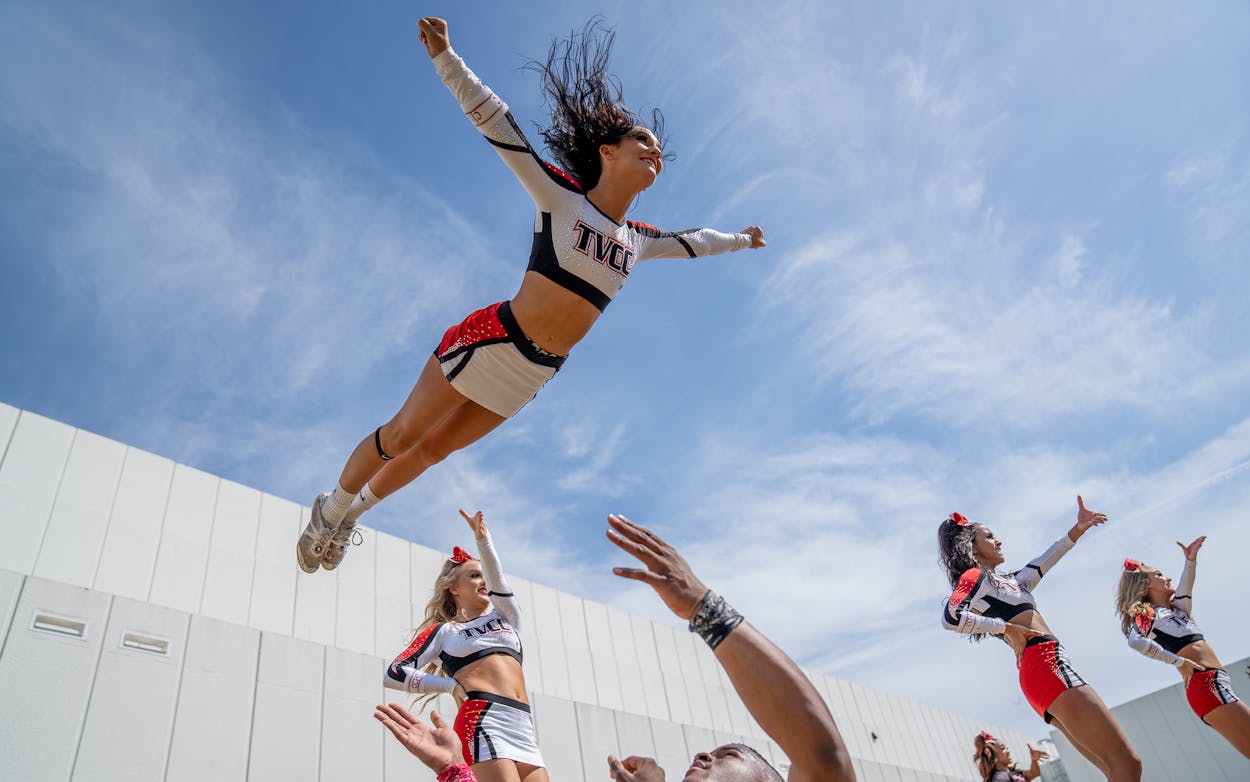Though it’s taken two years for the second season of Cheer to hit our Netflix accounts, the docuseries picks up in January 2020, just two weeks after the season-one premiere. In those few weeks, Coach Monica Aldama and the stars of Corsicana’s Navarro College cheerleading squad have become bona fide reality TV stars. They perform on Ellen, sign autographs, and interview celebrities on the Oscars red carpet. Aldama takes a leave of absence to appear on Dancing With the Stars.
The first season of the Emmy-winning series prioritized the physical pain and toughness of the sport, featuring shots of falls and injuries and incredible feats of strength. The plot, like a solid cheer routine, arched simply and formulaically, bending toward an annual championship competition in Daytona Beach, Florida.
In nine new episodes, series creator Greg Whiteley attempts to replicate a winning equation. The Navarro team is again preparing for “Daytona,” shorthand for the NCA College Nationals. This time, in a Bring It On–style construction, the audience is also privy to the preparations of the underdog squad at Trinity Valley Community College, located just a few miles down the road in Athens. This structure allows for the introduction of a new slate of star characters, including TVCC cheerleaders—but there was no way a simple sports-documentary formula was going to hold up under the chaos of the past two years.
Instead, the basic march to Daytona, which continues apace until the introduction of COVID in episode four, is shot through with competing narratives: the impact of fame, the pandemic and all of its implications, and the unrelenting pressure on Navarro College to live up to its runaway reputation. The uneven distribution of stories—heavy focus here, a light touch there—affects the season’s pacing at times, and snowballs into an overwhelming mess of heaviness. The show is not the same feel-good series it once was (though it again reached number one on Netflix).
The darkest pall over this season is cast by the arrest of Jerry Harris, one of the breakout stars of the original squad, loved for his peppy “mat talks.” In September 2020, fans learned that twin 14-year-old boys, who knew Harris through cheer, were suing the 22-year-old for sexual abuse. Harris was later arrested by the FBI on child pornography charges. Though we hear a cable news sound bite about the allegations at the top of the premiere, it isn’t until episode five that the chronological series catches up to Harris’s arrest and his teammates learn of them. Until then, Harris appears on screen mat-talking fans and recording Cameos for paying customers, a queasy choice by the producers. Harris’s accusers, their mother, and their lawyer all give on-camera interviews, which make for an episode that mines the discord between the accused’s alleged acts and his external persona. Coach Monica visibly tries to battle conflicting emotions on the subject, while squad member Gabi Butler says she can never turn her back on him because he is “family,” a decision the show seems to view with empathy. The only real denouncement of Harris comes from season one favorite La’Darius Marshall, who shared details of his own abuse with his teammate.
The show’s familial rhetoric comes up enough to turn a binge watch into a lethal drinking game. Again and again, squad mates refer to one another as brothers and sisters, with Coach Monica as the tough-loving mom. This go-round, the designation has soured. In one plot point, La’Darius, feeling abandoned by his coach, lashes out on social media. Another narrative follows the journey of Khris Franklin, a TVCC coach who seems to long for a literal family but can’t give up the dream of cheerleading championships—and the sense of belonging he finds in the gym—long enough to go out and create one. The viewer is invited to stare directly into the dark side of all the closeness and commitment valorized in season one.
That darkness imbues the season with a tone that bears little resemblance to the can-do attitude of the first, in which problems were just hurdles to vault over on the way to the trophy stand. In this season, the trials come too quickly and are far too complex to work out on the mat. The show can’t seem to choose whether to silo the complex plot lines in stand-alone episodes or weave them bluntly into a narrative about college cheer championships. The result is a disorienting season that echoes the uncertainties of the past two years; starts and stalls and weird digressions make for a choppy, uncomfortable ride. It’s hard to imagine audiences falling in love with this show, the same one that so captivated them two years ago.
Though the final two episodes veer back to the original plot line—Navarro versus Trinity Valley at Daytona—revealing the winner and pumping all the suspense built therein, the season, in the end, feels unsettled. Many of the issues presented in earlier episodes remain unsolved: the cheerleaders are still contending with COVID, Harris is awaiting a trial date, competition has come and gone, but to what end? The show concludes with updates on the various featured squad members, some of whom will return the following school year. In the face of such bleakness, all that’s left to do, it seems, is cheer.
Editor’s note: This post has been updated to correct the spelling of a name—it’s Gabi Butler, not Gaby.








